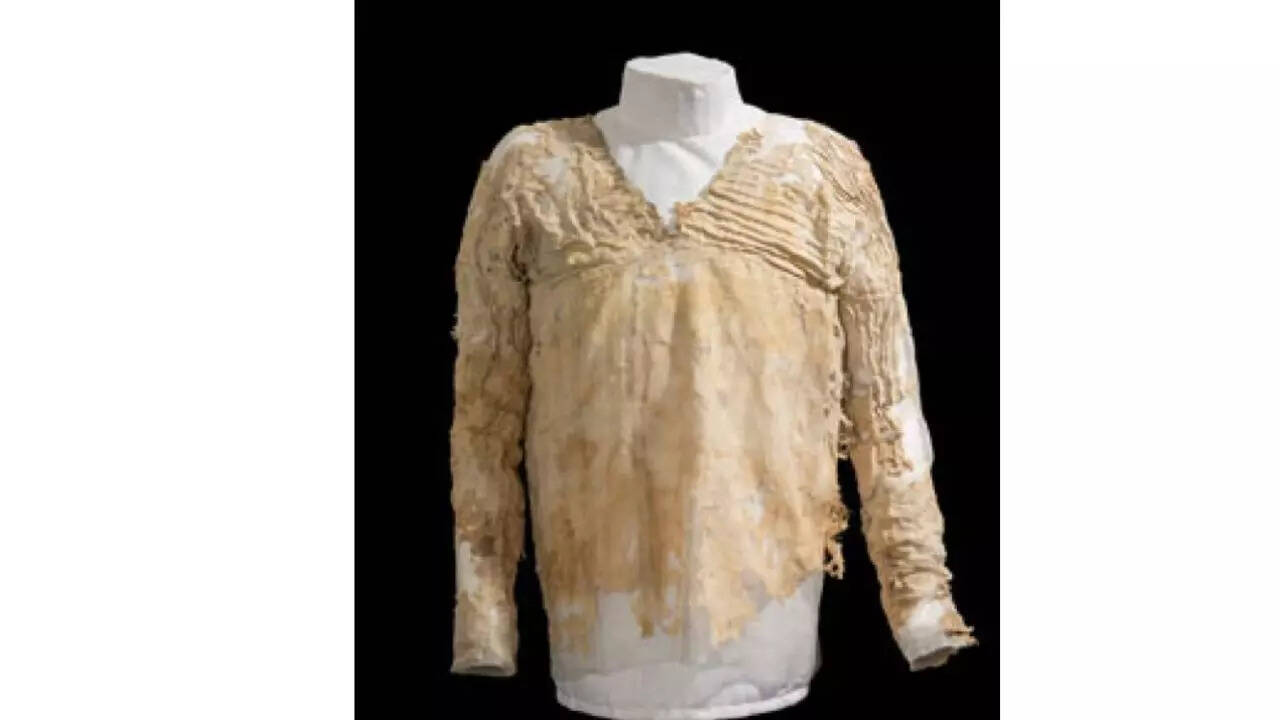World’s oldest dress discovered in Egypt after 5,000 years reveals ancient craftsmanship

The rare and remarkable relic of ancient fashion history discovered in Egypt’s Tarkhan Cemetery, south of Cairo. The Tarkhan Dress dated between 3482 and 3102 BC being the oldest known complex tailored clothing is the woven linen which means the garment designed to be cut, shaped, and sewn rather than simply wrapped and draped.
The Tarkhan garment, the oldest dress unearthed, underscores the sophistication of textile production dating back over 5000 years ago in addition to a direct linking to early Egyptian craftsmanship and social customs. This demonstrates that the clothing was more than functional even in the ancient world; expressive, culturally significant and made intricately.
Tarkhan Dress: The oldest known dress found in an Egyptian Cemetery
In 1913, the dress was first uncovered by the famed British archaeologist Sir Flinders Petrie during the excavation of a mastaba tomb which is flat-roofed and rectangular in design at the extensive tarkhan necropolis. This burial ground features over 2000 tombs back to the critical transition from Egypt’s Protodynastic to Early Dynastic periods, when the first pharaohs began to consolidate power.
The remnants believed to have been brushed aside by the ancient tomb robbers was a ‘pile of linen cloth’ which the archaeologist Petrie brought back to the UK. The garment was recognised until 1977 for decades when textile conservators of the Victoria and Albert Museum identified the fragments as of nearly complete linen dress.
Tarkhan Dress: Design and fabric used
The oldest dress discovered was crafted from fine linen woven from flax (Linum usitatissimum), featuring a modest V-shaped neckline, with tight sleeves and a knife-pleated bodice indicating advanced textile skills. Though its lower section is missing, experts believe it could have functioned as a tunic, shirt, or full-length dress. The garment’s size and style suggest it was made for a slim, young woman of elite status.
As noted by the Petrie Museum of Egyptian Archaeology at University College London (UCL), where the dress is now housed, this type of tailored clothing was uncommon in the archaeological record due to the fragile nature of ancient textiles.
Confirming the oldest dress age and cultural significance
In 2016, a study led by UCL’s Alice Stevenson and isotope chemist Michael Dee of the University of Groningen verified the dress’s age through advanced radiocarbon dating. The garment was confirmed to have been created around the dawn of Egypt’s First Dynasty, a period marking the unification of Upper and Lower Egypt under the first pharaohs.
Interestingly, signs of wear on the dress suggest it was used during life before being interred, countering the idea that it was made exclusively for funerary use. This practical wear, combined with visual depictions of similar garments in contemporary tomb art, reinforces the theory that the Tarkhan Dress was fashionable at the time. Beyond its age, the Tarkhan Dress represents a major breakthrough in the understanding of early clothing construction. As Stevenson noted, the survival of such a perishable textile especially in a nearly complete, tailored form which is extraordinarily rare.
Also Read | ‘Doomsday fish’ recently spotted four times in 20 days across countries including India; here’s where and what happened next
The Tarkhan garment, the oldest dress unearthed, underscores the sophistication of textile production dating back over 5000 years ago in addition to a direct linking to early Egyptian craftsmanship and social customs. This demonstrates that the clothing was more than functional even in the ancient world; expressive, culturally significant and made intricately.
Tarkhan Dress: The oldest known dress found in an Egyptian Cemetery
In 1913, the dress was first uncovered by the famed British archaeologist Sir Flinders Petrie during the excavation of a mastaba tomb which is flat-roofed and rectangular in design at the extensive tarkhan necropolis. This burial ground features over 2000 tombs back to the critical transition from Egypt’s Protodynastic to Early Dynastic periods, when the first pharaohs began to consolidate power.
The remnants believed to have been brushed aside by the ancient tomb robbers was a ‘pile of linen cloth’ which the archaeologist Petrie brought back to the UK. The garment was recognised until 1977 for decades when textile conservators of the Victoria and Albert Museum identified the fragments as of nearly complete linen dress.
Tarkhan Dress: Design and fabric used
The oldest dress discovered was crafted from fine linen woven from flax (Linum usitatissimum), featuring a modest V-shaped neckline, with tight sleeves and a knife-pleated bodice indicating advanced textile skills. Though its lower section is missing, experts believe it could have functioned as a tunic, shirt, or full-length dress. The garment’s size and style suggest it was made for a slim, young woman of elite status.
As noted by the Petrie Museum of Egyptian Archaeology at University College London (UCL), where the dress is now housed, this type of tailored clothing was uncommon in the archaeological record due to the fragile nature of ancient textiles.
Confirming the oldest dress age and cultural significance
In 2016, a study led by UCL’s Alice Stevenson and isotope chemist Michael Dee of the University of Groningen verified the dress’s age through advanced radiocarbon dating. The garment was confirmed to have been created around the dawn of Egypt’s First Dynasty, a period marking the unification of Upper and Lower Egypt under the first pharaohs.
Interestingly, signs of wear on the dress suggest it was used during life before being interred, countering the idea that it was made exclusively for funerary use. This practical wear, combined with visual depictions of similar garments in contemporary tomb art, reinforces the theory that the Tarkhan Dress was fashionable at the time. Beyond its age, the Tarkhan Dress represents a major breakthrough in the understanding of early clothing construction. As Stevenson noted, the survival of such a perishable textile especially in a nearly complete, tailored form which is extraordinarily rare.
Also Read | ‘Doomsday fish’ recently spotted four times in 20 days across countries including India; here’s where and what happened next
Next Story